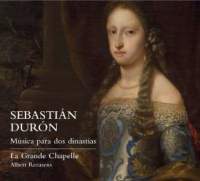Texte paru dans: / Appeared in: Lauda |
|
|
Outil de traduction ~ (Très approximatif) |
|
|
Reviewer: Bertil
van Boer It is probably a sure bet that few are aware of Spanish Baroque composer Sebastián Durón (1660–1716), a contemporary of Alessandro Scarlatti. As maestro di capilla under both Charles II, the last Hapsburg, and Philip V, the first Bourbon king of Spain, he bridged one of the more contentious times in Iberian history. He did not emerge unscathed, however, for in 1706 he was dismissed from his post for his pro-Austrian leaning and exiled to France. There he lived out the rest of his life as the personal music master to the widow of Charles II, Mariana of Neuberg in Bayonne, but he was able to mitigate his exile by suing the new court to obtain his music written for the Spanish court. Unfortunately, this was dispersed following his death, and its whereabouts remains unknown.
What is left seems to have been discovered in fits and starts, with a surprising amount already available given his current obscurity and even complaints about his style dating from his lifetime. For the former, we have a recording of his one-act opera La Guerra de los Gigantes from 2012 on Pan Classics, as well as a set of his songs and the occasional instrumental work entitled Lágrimas, Amor, likewise on Pan Classics (reviewed last year in 36:9), not to mention bits and pieces on a number of recordings over the past two decades. This disc focuses on works written especially for the Madrid courts of the two contenders. They are mainly sacred, but they also contain a mixture of traditional and Catholic styles, from villancicos and jácaras to normal motets and responsories. Even these are all in Spanish, which was not unusual for the period.
The music itself, on the whole, is bright and lively. The opening Dulce armonía with its clarion trumpet solo and fanfare-like rhythmic structure is an excellent way to announce Durón’s music with an imperial sound. The villancico Ay infelice, in contrast, seems like a gentle madrigal with a softly-strumming guitar continuo. The gentle major-key sonorities seem melodious, though the textures are a bit old-fashioned. This contrasts with the proclamation of the second villancico Ay, cómo cantan, where the expostulation of the first word acts as a sort of motivic call throughout. This is followed by a solo aria describing an erratically flying Cupid, sounding like something out of a Cavalli opera, though with the usual Spanish rhythmic inflections. Váya, pues, rompiendo ed aire is a jaunty jácara, and the dance rhythms persist even into the occasional bits of coloratura. It is bright and cheerful. The final movement, Dulce clarin sonoro in eight parts, ends the disc with the same bright fanfares with solo trumpet that began it, with the voices flowing easily in their homophonic cries. Solo voices add various stanzas that pirouette like dances, each punctuated by the trumpet refrain. It is joyous music, and while one might wonder if the “dynasties” are reflected within in any specific manner, it is clear that Durón was at the top of his game in composing original music for whichever court he happened to serve.
As far as
the performance goes, it is excellent. La Grande Chapelle performs the music
with a close eye to good phrasing, fine ensemble, and precise but flexible
rhythmic structure, all of which make this come alive. This alone brings
light to Durón’s undeserved obscurity. This comes highly recommended and
will probably make my Want List for this year.
| |
|
Support us financially by purchasing this disc from eiher one of these suppliers. Un achat via l'un ou l'autre des fournisseurs proposés contribue à défrayer les coûts d'exploitation de ce site. |
|
|
|
|
|
Cliquez l'un ou l'autre
bouton pour découvrir bien d'autres critiques de CD |
|




